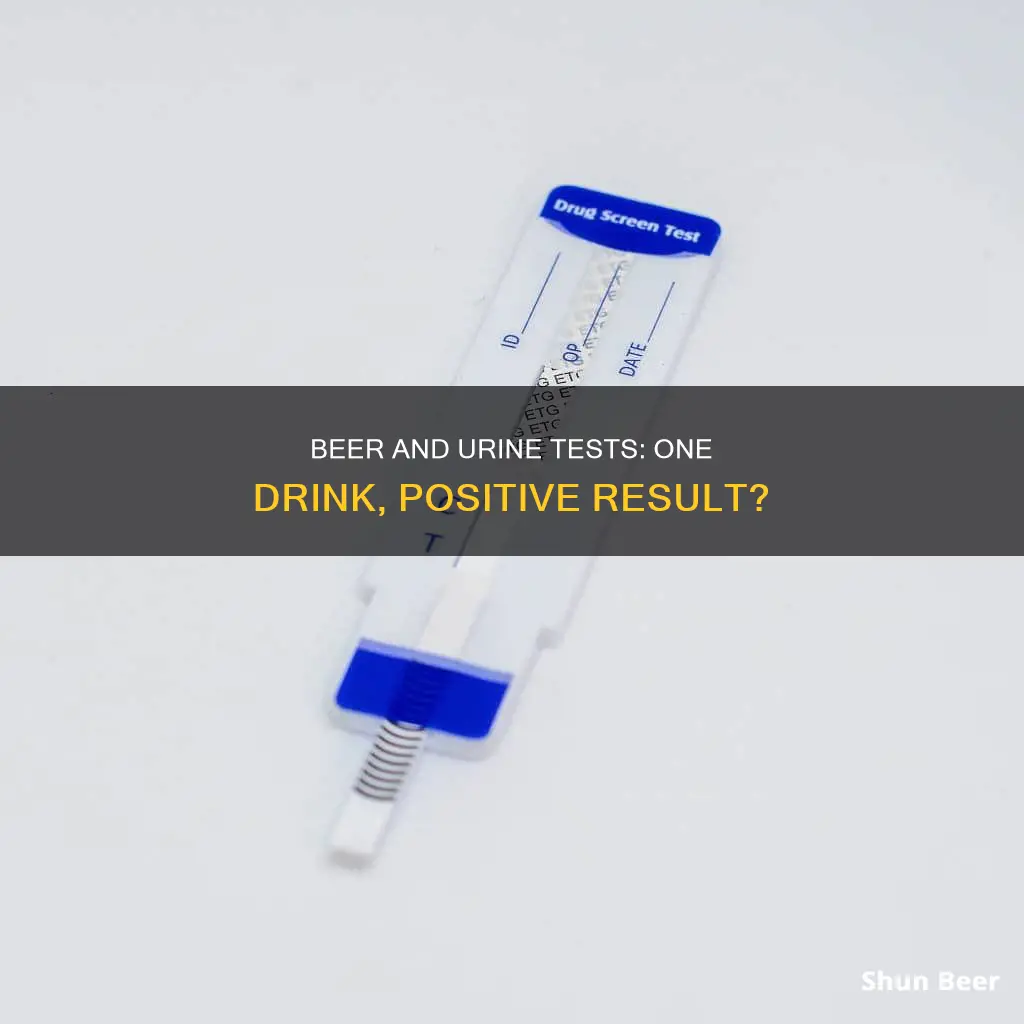
Alcohol can be detected in the body through blood and urine tests, which can measure either the presence of alcohol itself or its metabolites, such as ethyl glucuronide (EtG). Urine tests are highly sensitive and can detect even very small amounts of alcohol for up to 80 hours after consumption. While non-alcoholic beverages typically contain less than 0.5% alcohol by volume, this is still enough to potentially trigger a positive result on some alcohol tests. This is especially true if consumed in larger quantities, as the amount of alcohol ingested and the speed of consumption are factors in determining the likelihood of a positive test result.
| Characteristics | Values |
|---|---|
| Can one beer cause a positive urine test result? | Yes, if the beer is alcoholic. |
| How long can alcohol be detected in urine? | Up to 80 hours after consumption, depending on the test. |
| What is the typical detection window for ethanol urine tests? | 12 hours |
| What is the typical detection window for ethyl glucuronide (EtG) urine tests? | 24–72 hours |
| What is the typical detection window for ethyl sulfate (EtS) urine tests? | 24–72 hours |
| What factors can influence the detection of alcohol in urine tests? | Test sensitivity, alcohol concentration, consumption quantity and speed, individual factors like weight and metabolism. |
| What are some other reasons for false positives on alcohol urine screens? | Bacteria growth due to improper sample storage, urinary tract infection in diabetic individuals. |
What You'll Learn
- Urine tests can detect alcohol up to 12 hours after drinking
- Advanced urine tests may detect alcohol up to 24 hours after drinking
- Non-alcoholic beer may cause a positive urine test result
- Ethyl glucuronide (EtG) urine tests are highly sensitive
- False positives can occur due to products containing alcohol

Urine tests can detect alcohol up to 12 hours after drinking
Urine tests can detect alcohol in the body for varying periods, depending on the type of test and individual factors such as metabolism and hydration levels. Most standard urine tests can detect alcohol up to 12 hours after drinking, while advanced urine tests may detect alcohol for up to 24 hours.
The ethanol urine test, which measures unmetabolised alcohol, typically detects alcohol within this timeframe—up to 12 hours after consumption. This test is limited in that it can only identify very recent alcohol use because ethanol is eliminated from the body relatively quickly.
However, the body also produces alcohol metabolites during the processing of alcohol, and these metabolites can remain in the body for longer than the alcohol itself. The ethyl glucuronide (EtG) urine test and the ethyl sulfate (EtS) urine test detect these metabolites. The detection window for these tests is usually between 24 and 72 hours, but the metabolites may be detected for up to 80 hours after alcohol consumption, especially with heavy drinking.
It is important to note that even products containing small amounts of alcohol can cause a positive result on a urine test. This includes mouthwash, breath spray, non-alcoholic beers and wines, kombucha, fermented foods, alcohol-based sanitisers and cosmetics, and cleaning products.
Beer and Mono: Is It Safe to Drink?
You may want to see also

Advanced urine tests may detect alcohol up to 24 hours after drinking
The length of time that alcohol can be detected in the urine depends on the type of test and individual factors such as metabolism rate and hydration levels. Most urine tests can detect alcohol up to 12 hours after drinking. However, advanced urine tests, such as the ethyl glucuronide (EtG) test, can detect alcohol metabolites in the urine for up to 24 hours after drinking. EtG is a highly sensitive test that can detect even trace amounts of alcohol consumption. It is designed to detect alcohol consumption at higher levels, so it is unlikely to show positive results for non-alcoholic beverages.
The detection period for EtG tests typically ranges from 24 to 72 hours after alcohol consumption. However, in some cases, EtG can be detected in the urine for up to 80 hours after drinking, especially with heavy drinking. This variability in detection time is due to several factors, including the sensitivity of the test, the concentration of alcohol consumed, the amount and rate of consumption, and individual body factors such as weight and metabolism.
It is important to note that even if a person feels sober, alcohol metabolites can remain in the body for an extended period. These metabolites are what urine tests, especially the EtG test, are designed to identify. Therefore, it is possible to test positive for alcohol on a urine test even after the effects of alcohol have worn off.
To ensure accurate urine test results, it is recommended to maintain clean hands and genitalia, use a clean container, and ensure the test is sealed and hasn't expired. Avoiding products that contain alcohol, such as mouthwash, non-alcoholic beverages, and cleaning products, is also crucial before taking a urine alcohol test.
Beer and Dark Stool: Is There a Link?
You may want to see also

Non-alcoholic beer may cause a positive urine test result
Non-alcoholic beer typically contains very low levels of alcohol, usually less than 0.5% by volume. While this is generally considered safe for those who need to abstain from alcohol due to testing, it is important to note that consuming large amounts of non-alcoholic beer in a short period could potentially lead to a positive urine test result, although this is rare.
Urine tests like the ethyl glucuronide (ETG) test are designed to detect alcohol consumption at higher levels. The ETG test, for example, can detect even trace amounts of alcohol consumption. However, non-alcoholic beer typically does not show up on this test because of its low alcohol content.
Detection periods for ETG tests range from 24 to 72 hours after alcohol consumption. Since non-alcoholic beer contains minimal alcohol, it is unlikely to be detected in urine tests, even after consuming a large amount.
However, a study found that volunteers who consumed 2.5 litres of non-alcoholic beer (with an alcohol content of 0.5%) showed positive results on some urine tests. These instances are rare and would typically require a significant amount of non-alcoholic beer to be consumed.
In summary, while it is unlikely for non-alcoholic beer to cause a positive urine test result, it is not completely impossible. If you are subject to alcohol testing, it is essential to exercise caution and be aware of any restrictions or requirements.
Non-Alcoholic Beers: A Safe Alternative?
You may want to see also

Ethyl glucuronide (EtG) urine tests are highly sensitive
The sensitivity of the EtG test makes it a valuable tool in various situations that require alcohol abstinence, such as alcohol treatment programs, court cases, liver transplant patients, and professional monitoring programs. The test can also be used to screen for EtG in blood, hair, and nails, but the urine test is the most widely used.
It is important to note that the EtG test has some limitations. It can produce a positive result from exposure to alcohol-containing products such as hygiene products and food items. Additionally, drinking water or other fluids may help flush EtG out of the system, but it is not a reliable method for manipulating test results as laboratories can detect tampering with urine samples.
The test is not recommended for workplace testing programs as it does not measure current impairment from alcohol. However, it is a highly useful test for detecting recent alcohol consumption, with a 70% accuracy rate that increases to 85% for moderate to heavy drinking.
Celiac-Friendly Dark Beer: What You Need to Know
You may want to see also

False positives can occur due to products containing alcohol
Therefore, it is important to avoid any products that contain alcohol before taking a urine test. This includes certain consumables and hygiene products, such as mouthwash, breath spray, non-alcoholic beers and wines, kombucha, fermented foods, alcohol-based sanitizers and cosmetics, and cleaning products. Even natural fermentation processes in some foods like bread, orange juice, and ripe bananas can produce small amounts of alcohol, which could potentially affect the results of a urine test.
The sensitivity of the urine test also plays a role in the possibility of a false positive. The ethyl glucuronide (EtG) test, for example, is highly sensitive and can detect even trace amounts of alcohol consumption. This means that even minimal alcohol intake, such as from non-alcoholic beverages, could potentially cause a positive test result, especially if consumed in larger quantities.
To avoid false positives, it is recommended to opt for products that are labelled as 0.0% ABV, as these are formulated to be entirely free of alcohol. However, even these products are not completely foolproof due to the potential presence of trace amounts of alcohol from natural fermentation in other foods.
In summary, to ensure accurate results on a urine test, it is best to avoid any products that contain alcohol, even in small amounts. This includes both ingested products and external products that may come into contact with the body.
Drinking Beer and Driving: How Many is Too Many?
You may want to see also
Frequently asked questions
It depends on the type of beer and the test. Non-alcoholic beers typically have less than 0.5% alcohol content, and are unlikely to cause a positive urine test result. However, some standard urine tests can detect alcohol up to 12 hours after your last drink, and advanced tests may detect alcohol up to 24 hours after drinking.
There are two types of urine tests: the immunoassay test and the gas chromatography or mass spectrometry (GC/MS) test. The immunoassay test is quicker and cheaper, but it can sometimes produce false positives. The GC/MS test is more expensive and takes longer, but it rarely produces false positives.
The outcome of a urine test depends on the sensitivity of the test, the concentration of alcohol in the beverage, how much and how quickly the beverage was consumed, and individual body factors like weight and metabolism.
Products containing alcohol, such as some cough syrups, non-alcoholic beverages, and foods prepared with alcohol, can cause a positive urine test result. Other factors include improper storage of the urine sample and urinary tract infections in people with diabetes.







